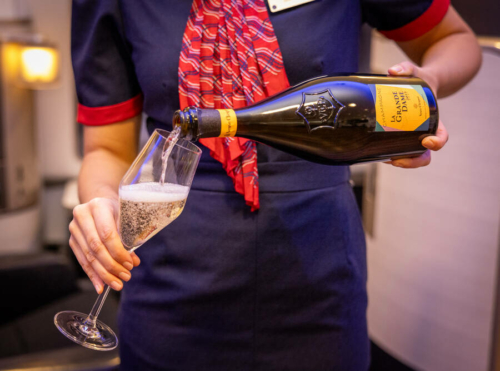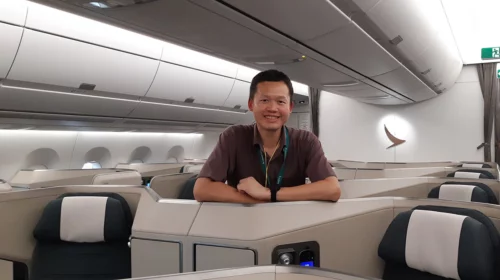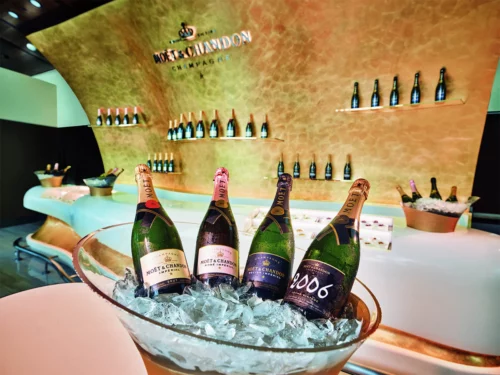How do airlines choose which champagne and wine to serve? We find out
Links on Head for Points may support the site by paying a commission. See here for all partner links.
“For many, enjoying a glass of champagne before take-off is a cherished ritual, marking the beginning of their journey and a moment to unwind” says Ronald Khoo at Cathay Pacific.
The last thing on your mind when sipping on a glass of champagne at 35,000 feet is how the bottle got there. Yet, behind the scenes, a surprising amount of thought and work goes into selecting what is served.
The process is not as simple as heading to your local wine merchant and saying “that one with the pretty label.” More often than not, an airline’s hands are tied when it comes to choice.
For example, earlier this year, British Airways announced it was switching its First Class champagne after 12 years of Laurent-Perrier Grand Siècle. In that particular case, the decision was out of BA’s control: Laurent-Perrier had decided it no longer wanted to offer Grand Siècle to the travel market and that was that.
BA wouldn’t let me talk to their Master of Wine Tim Jackson MW, so I spoke to Cathay Pacific’s Wine, Spirits & Beverages Manager Ronald Khoo, instead (pictured below).
1.5 million bottles, sitting on the wall
One of the biggest barriers to champagne selection is the sheer volumes required. Airlines are the biggest buyers of wines and champagnes in the world but “the limited availability of each selected Champagne cannot usually supply the entire year’s demand.”
On a typical flight, Virgin Atlantic has said it serves anywhere between nine and twelve bottles of champagne. Emirates, one of the largest airlines in the world, serves 1.5 million bottles of wine per year to its business class and first class passengers, whilst over 150,000 bottles of Moët are opened in its lounges in Dubai.
Many smaller, boutique champagne houses do not produce enough bottles to supply even a single airline, let alone multiple. Only the largest houses – grandes marques – can quench demand from passengers, limiting choice even further.
One way to mitigate this is to offer a rotation of bottles throughout the year, rather than have a single supplier. “Our champagne selection for Business class is typically reviewed every 3-4 months, resulting in approximately four rotations per year.”
For frequent flyers this introduces an element of variety and allows the airline to showcase champagnes with varying taste profiles to appease all passengers. Clever marketing can make this seem like luxurious, even seasonal, curation rather than a function of supply and demand.

It’s all in the nose
Of course, that still leaves plenty of choice available: Laurent-Perrier, Krug, Dom Perignon, Veuve Cliquot, Moët & Chandon, Pommery and Lanson are just a few of the major houses spotted on board.
“We ensure that the champagne is technically flawless, with no defects. The taste profile is also crucial; the champagne should not be overly acidic or alcoholic and should have a substantial flavour.”
Crucially, what tastes good on the ground may not be up to snuff in the clouds: a study by Germany’s Fraunhofer Institute for Building Physics has shown that taste changes at altitude in cabin environment by as much as 30% for some flavours. “Tannins and oak flavours become more pronounced, meaning the wine can taste more bitter and unbalanced.”
It’s not just your tastebuds that suffer from altitude sickness. The dry cabin environment is just as detrimental:
“Lower humidity dries out nasal passages, impairing our ability to smell properly. If we can’t smell the champagne, it seems less appealing.”
That’s partly why you’ll often find different champagnes offered on board versus in airport lounges.
“For in-flight service, we choose champagnes with more robust flavours to compensate for the sensory changes that occur at high altitudes.”
All that glitters is gold
Partnering with champagne houses can also burnish an airline’s own brand. As much as many airlines would like to view themselves as luxury brands, the truth is that their reputation is far behind that of Krug, Laurent-Perrier and Dom Perignon, most of which are owned by luxury conglomerates.
By serving these champagnes on board, airlines hope that some of the shine rubs off on them.
Often these partnerships span decades: Cathay Pacific has “longstanding partnerships with several prestigious champagne houses, such as Krug (since 1986), Tattinger, Deutz, and Billecart-Salmon.”
Emirates has just renewed its exclusive deal with eight key champagnes until 2028. If you want to drink Dom Pérignon Vintage 2013, Dom Pérignon Vintage Rosé 2008, Dom Pérignon Plénitude 2 2004, Moët & Chandon Brut Imperial, Moët & Chandon Imperial Rosé, Moët & Chandon Grand Vintage Blanc 2013, Veuve Clicquot Yellow Label or Veuve Clicquot Vintage Blanc 2015 on board, you need to book on Emirates.
Over time, partnerships can deepen beyond merely serving a particular bottle on board. Emirates’ strong partnership with Moët & Chandon has led it to open a co-branded Moët & Chandon Champagne bar in one of its lounges in Dubai. British Airways, meanwhile, recently introduced a Whispering Angel bar at Heathrow Terminal 5B.






 Rob
Rob 





Comments (49)